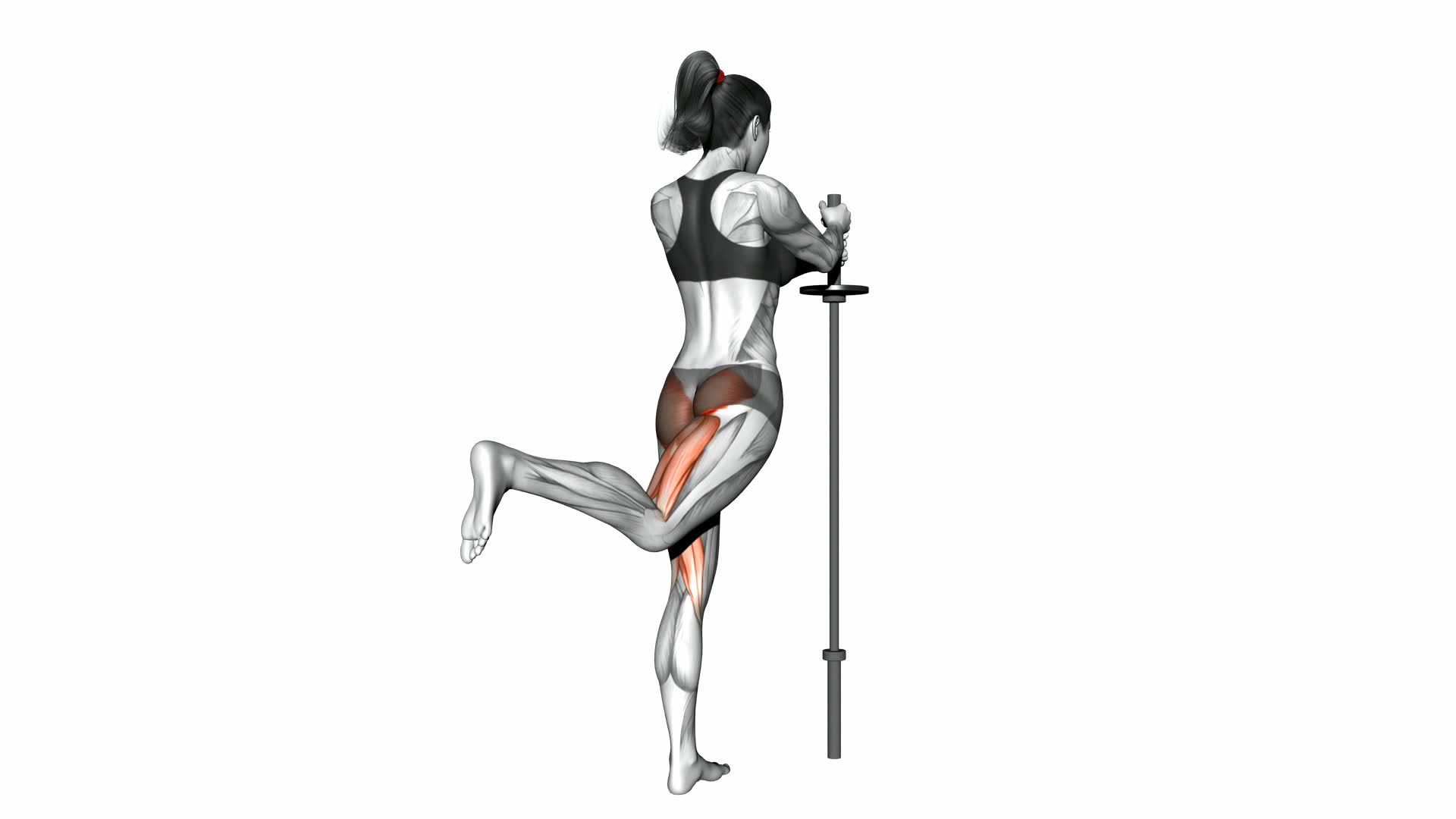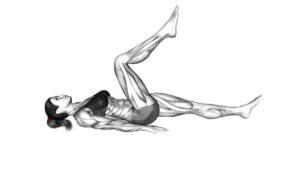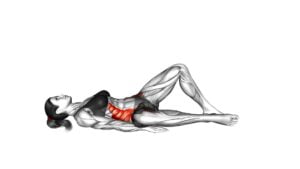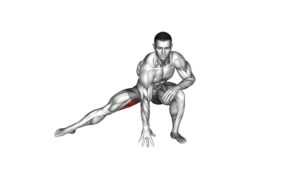Standing Hip Extension (Bent Knee) – Video Exercise Guide & Tips

Are you looking to strengthen your hip muscles? In this video exercise guide, we'll show you how to perform a standing hip extension with a bent knee.
Watch This Exercise Video
By following the step-by-step instructions and tips, you'll learn proper form and technique for maximum results. Whether you're a beginner or an experienced fitness enthusiast, this exercise can be modified to suit your needs.
Get ready to sculpt and tone your hips with this effective workout. Let's get started!
Key Takeaways
- Proper form and technique are essential for performing the standing hip extension exercise correctly.
- The standing hip extension exercise strengthens the glute muscles, improves hip stability, and enhances lower body strength.
- Engaging the core muscles and maintaining proper form helps to prevent lower back strain and injury.
- Variations of the standing hip extension exercise, such as using resistance bands or unstable surfaces, can add challenge and improve results.
Proper Form and Technique
To perform the standing hip extension (bent knee) exercise correctly, position yourself with your feet shoulder-width apart and your hands resting on your hips. This exercise is a great way to target your glute muscles and improve hip stability.
However, it's important to be aware of common mistakes, as well as the benefits and precautions associated with this exercise.
One common mistake people make is arching their lower back excessively. This not only reduces the effectiveness of the exercise but also puts unnecessary strain on the lower back. To avoid this, engage your core muscles and maintain a neutral spine throughout the movement.
Another mistake is lifting the leg too high. While it may seem like a good idea to increase the range of motion, lifting the leg beyond hip level can lead to overextension and strain on the hip joint. Instead, focus on lifting the leg until it's parallel to the ground.
When performed correctly, the standing hip extension (bent knee) exercise offers several benefits. It strengthens the glute muscles, which play a crucial role in hip stability and overall lower body strength. Additionally, it can help improve balance and posture.
Before attempting this exercise, it's important to take certain precautions. If you have any pre-existing hip or lower back issues, it's best to consult with a healthcare professional before attempting this exercise. Additionally, start with a lighter resistance or bodyweight and gradually increase the intensity as you build strength and confidence.
Equipment Needed
You will need a resistance band for the standing hip extension (bent knee) exercise. The resistance band adds an extra challenge to the exercise by providing resistance against your leg movement. This helps to strengthen and tone your hip muscles, particularly the glutes and hamstrings.
Using a resistance band for the standing hip extension (bent knee) exercise offers several benefits. Firstly, it helps to improve hip stability and balance, as you have to engage your core muscles to maintain proper form throughout the movement. Additionally, the resistance band increases the intensity of the exercise, making it more effective for building strength and muscle endurance in the hips and thighs.
However, it's important to be aware of some common mistakes when using a resistance band for this exercise. One common mistake is using a band that's too tight or too loose. The band should provide enough resistance to challenge your muscles, but not so much that it compromises your form or causes discomfort. Another mistake isn't maintaining proper posture. Make sure to keep your back straight, shoulders down, and core engaged throughout the movement.
Step-by-Step Instructions
For the standing hip extension (bent knee) exercise using a resistance band:
- Begin by securing the band around your ankles.
- Stand with your feet shoulder-width apart and your knees slightly bent.
- Keep your core engaged and your back straight throughout the exercise.
To perform the standing hip extension:
- Start by shifting your weight onto one leg while keeping the opposite leg slightly bent.
- Slowly lift your bent leg straight back, maintaining a slight bend in the knee.
- As you lift your leg, squeeze your glutes and focus on engaging the muscles in your hip.
Avoid swinging or using momentum to lift your leg:
- This can lead to improper form and decrease the effectiveness of the exercise.
- Instead, focus on controlled movements and maintain proper alignment.
Incorporating standing hip extension into your workout routine offers several benefits:
- This exercise targets the gluteus maximus, hamstrings, and hip abductors, helping to strengthen and tone these muscles.
- It also improves hip stability and mobility, which is beneficial for everyday activities and sports performance.
- Additionally, the standing hip extension can help correct muscle imbalances and improve posture.
Tips for Maximum Results
Maximize your results with these tips for the standing hip extension (bent knee) exercise.
- Maintain proper form: To ensure maximum effectiveness and prevent injury, it's crucial to maintain proper form throughout the exercise. Keep your core engaged, shoulders relaxed, and spine neutral. Avoid excessive arching or rounding of the back.
- Control your movements: Focus on controlling the movement of your leg throughout the exercise. Avoid swinging the leg or using momentum to lift it. Instead, use your hip muscles to lift the leg and squeeze your glutes at the top of the movement.
- Gradually increase resistance: As you become more comfortable with the exercise, gradually increase the resistance by using ankle weights or resistance bands. This will challenge your muscles and help you achieve better results over time.
- Listen to your body: Pay attention to any discomfort or pain during the exercise. If you experience any, stop immediately and consult with a healthcare professional. It's important to prioritize safety and avoid pushing yourself too hard.
Variations and Modifications
To add variety and adapt the standing hip extension (bent knee) exercise to your fitness level and goals, there are several variations and modifications that can be incorporated. These variations allow you to adjust the intensity of the exercise and target specific muscle groups more effectively.
One way to modify the standing hip extension (bent knee) exercise is by incorporating resistance bands. By attaching a resistance band around your ankle and anchoring it to a sturdy object, you can increase the resistance and challenge your hip muscles even more. This variation is particularly useful for individuals looking to build strength and tone their glutes and hamstrings.
Another modification is to perform the exercise on an unstable surface, such as a Bosu ball or a balance board. This adds an element of instability, forcing your muscles to work harder to maintain balance. By engaging your core and stabilizer muscles, you can further enhance the effectiveness of the exercise.
If you're looking to increase the intensity of the standing hip extension (bent knee) exercise, you can try doing it with a weight plate or a dumbbell. By holding the weight against your thigh or gripping it with your foot, you add resistance and challenge your muscles more. This variation is beneficial for individuals who've already mastered the basic exercise and want to continue progressing.
Frequently Asked Questions
How Many Sets and Repetitions Should I Do for Standing Hip Extension (Bent Knee)?
To determine the number of sets and repetitions for standing hip extension (bent knee), consider your fitness level and goals. Start with 2-3 sets of 10-12 repetitions per leg.
Maintain proper technique by keeping your core engaged and your knee bent at a 90-degree angle. This exercise targets your glutes and hamstrings, improving lower body strength and stability.
To add variation, you can use resistance bands or ankle weights. Alternatively, try alternatives like glute bridges or donkey kicks.
Can Standing Hip Extension (Bent Knee) Help With Improving My Balance?
Standing hip extension with a bent knee can indeed help improve your balance. By engaging your core muscles and stabilizing your body, this exercise challenges your balance and strengthens the muscles in your hips and glutes.
The movement also activates your hip extensors, which are important for maintaining stability and control. Incorporating this exercise into your routine can be beneficial for enhancing your overall balance and stability.
Is It Necessary to Warm up Before Performing Standing Hip Extension (Bent Knee)?
To maximize the benefits of standing hip extension (bent knee) and prevent injury, warming up beforehand is crucial. A proper warm-up increases blood flow, loosens muscles, and prepares your body for the exercise.
However, if you prefer alternatives for hip mobility, you can try other exercises like hip circles, leg swings, or clamshells.
Can Standing Hip Extension (Bent Knee) Be Performed With Ankle Weights or Resistance Bands?
Yes, you can perform standing hip extension (bent knee) with ankle weights or resistance bands. This variation adds extra resistance to the exercise, increasing the challenge and targeting your glutes even more effectively.
Standing hip extension (bent knee) with ankle weights or resistance bands can help activate and strengthen your glute muscles, improving your overall lower body strength and stability.
Are There Any Common Mistakes to Avoid When Performing Standing Hip Extension (Bent Knee)?
When performing standing hip extension (bent knee), it's important to be aware of common mistakes to avoid and focus on proper form. By understanding these errors, you can maximize the effectiveness of the exercise and prevent injuries.
Maintaining a stable core, avoiding excessive arching of the lower back, and controlling the movement throughout the entire range of motion are key aspects of proper form.
Conclusion
In conclusion, standing hip extension (bent knee) is an effective exercise for targeting the glutes and hamstrings. By following the proper form and technique, using the necessary equipment, and following the step-by-step instructions, you can maximize your results.
Additionally, there are variations and modifications available to cater to different fitness levels and goals. Incorporating this exercise into your routine can help improve hip strength and overall lower body stability.

Author
Years ago, the spark of my life’s passion ignited in my mind the moment I stepped into the local gym for the first time. The inaugural bead of perspiration, the initial endeavor, the very first surge of endorphins, and a sense of pride that washed over me post-workout marked the beginning of my deep-seated interest in strength sports, fitness, and sports nutrition. This very curiosity blossomed rapidly into a profound fascination, propelling me to earn a Master’s degree in Physical Education from the Academy of Physical Education in Krakow, followed by a Sports Manager diploma from the Jagiellonian University. My journey of growth led me to gain more specialized qualifications, such as being a certified personal trainer with a focus on sports dietetics, a lifeguard, and an instructor for wellness and corrective gymnastics. Theoretical knowledge paired seamlessly with practical experience, reinforcing my belief that the transformation of individuals under my guidance was also a reflection of my personal growth. This belief holds true even today. Each day, I strive to push the boundaries and explore new realms. These realms gently elevate me to greater heights. The unique combination of passion for my field and the continuous quest for growth fuels my drive to break new ground.







